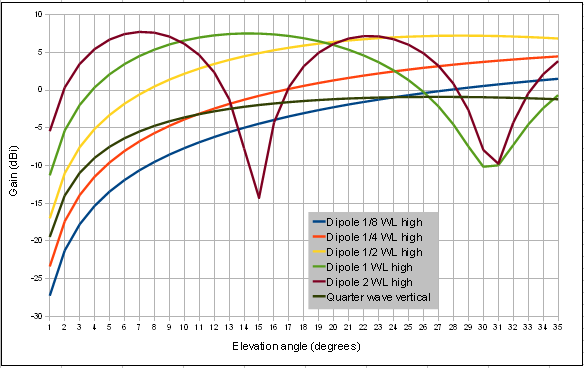You are using an out of date browser. It may not display this or other websites correctly.
You should upgrade or use an alternative browser.
You should upgrade or use an alternative browser.
-
You can now help support WorldwideDX when you shop on Amazon at no additional cost to you! Simply follow this Shop on Amazon link first and a portion of any purchase is sent to WorldwideDX to help with site costs.
Base Maco Big Dog Antennas
- Thread starter Riverman
- Start date
The advantage of stacking is the different take off angles. Put one at 1/2 wavelength high and one at 1 wavelength high. The lower one will have far more gain than the higher one for short distance and can be up to 15dB better. Long distance you switch to the one at 1 wavelength high.


The advantage of stacking is the different take off angles. Put one at 1/2 wavelength high and one at 1 wavelength high. The lower one will have far more gain than the higher one for short distance and can be up to 15dB better. Long distance you switch to the one at 1 wavelength high.

I would love to know where you got this chart. It looks like a rather odd way of showing what you are talking about, although I did recently see something similar in an old add in another thread on this forum. Or perhaps I am just used to looking at plots made with modeling software, like the one below.
Here is a dipole at 1/2 wavelength in height, compared to a dipole at 1 wavelength in height, compared to the two of them stacked...

The DB
The advantage of stacking is the different take off angles. Put one at 1/2 wavelength high and one at 1 wavelength high. The lower one will have far more gain than the higher one for short distance and can be up to 15dB better. Long distance you switch to the one at 1 wavelength high.
I have seen large antennas such as the Moonraker 4 stacked side by side but can't recall ever seeing one over the other. Certainly not with a 1/2 wavelength distance between them.
I thought the purpose of stacking such antennas was to get additional gain; not to have a choice in takeoff angles between the two.
I believe something has been lost in translation here.
You can cram too many elements on a boom and hurt gain. I know most run the 7 element over the 8 because it’s a lot cheaper and I’m not sure who did the testing but claimed the 7 had a little more gain. I didn’t do the testing and I’m not sure it’s true but it was someone on this site. I think a guy I thought had clue.
You can cram too many elements on a boom and hurt gain.....
Boom length is more of a gain factor than # of elements.
IMO , one you go past 3 or 4 elements , if you want more gain going higher is a better investment than a longer boom/more elements .
I have 5 and would not want to worry about more up there with the wind we get.
A little confusion slipped in about the stacking. There are guys that do stack one over the other but those are just single polarity antennas stacked horizontally over each other. Not dual polarized antennas. You see a lot of guys that do contesting doing it on the amature bands. There's a guy out of Italy I'm sure I'm spelling his name wrong Giancarlo that comes booming into the states on 38 LSB or ch.6 Am that runs stacked one over the other 5 element beam antennas.I have seen large antennas such as the Moonraker 4 stacked side by side but can't recall ever seeing one over the other. Certainly not with a 1/2 wavelength distance between them.
I thought the purpose of stacking such antennas was to get additional gain; not to have a choice in takeoff angles between the two.
I believe something has been lost in translation here.
